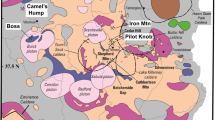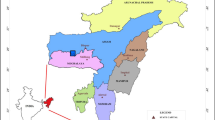Abstract
The Ambaji–Deri region is located in the northeastern part of the Gujarat state of India and is well-known for hosting lead–zinc–copper minerals deposits. Recently, gravity and magnetic data are collected in the region with the objective of geological and structural mapping of the area. This data is further processed using upward continuation, derivative analysis, and 2.5-dimensional gravity modelling to understand the subsurface geometry for mineral exploration. The upward continued regional gravity anomaly reveals high value in SW part of the region. The residual gravity and magnetic anomaly show the NE–SW trend, which is sympathetic with the general trend of Delhi supergroup. The high values of the residual Bouguer and the magnetic anomaly at the junction of the Jaisalmer–Barwani and the Chambal–Jamnagar lineaments are inferred as possible potential sites for sulphide mineralisation. The horizontal gradient of the tilt derivative (HGTD) of both the gravity and the magnetic anomalies reveals NE–SW trending lineaments. Based on the results of HGTD, several new structural features have been identified and a refined lineament map of the study area is proposed. The gravity modelling using residual Bouguer anomaly could delineate a high-density intrusive body in the upper crustal level. The result of the gravity model also confirms that the middle crust is uplifted by 1–3 km in the eastern part of the study area. In this study, three prospective zones for base metal mineralisation have been identified.






Similar content being viewed by others
References
Abu-Hamatteh Z S H 2002 Geochemistry and tectonic framework of proterozoic mafic metavolcanics of Aravalli–Delhi Orogen, NW India; Geochemistry 62 123–144, https://doi.org/10.1078/0009-819-00016.
Aina A 1991 Transformation of magnetic intensity anomalies over the Chad Basin into gravity field; Nigerian Assoc. Petro. Explor. Bull. 6 89–93.
Bakliwal P C and Ramaswamy S M 1987 Lineament fabric of Rajasthan and Gujarat; Rec. Geol. Surv. India 113(7) 54–64.
Baranov V 1957 A new method for interpretation of aeromagnetic maps: Pseudo-gravimetric anomalies; Geophysics 22 359–383.
Bhagat S N 2012 Occurrence of gold mineralisation in rocks of Proterozoic Delhi Supergroup around Ambaji, Banaskantha District, Gujarat; Curr. Sci. 103 23–24.
Bhattarajee J, Golani P R and Reddy A B 1988 Rift related bimodal volcanism and metallogeny in the Delhi fold belt, Rajasthan and Gujarat; Ind. J. Geol. 60 191–199.
Blakely R J 1995 Potential theory in gravity and magnetic applications; Cambridge University Press, pp. 182–210, 311–358.
Chandra U 1977 Earthquakes of peninsular India – a seismotectonic study; Bull. Seismol. Soc. Am. 67(5) 1387–1413.
Chopra S, Chang T M, Saikia S, Yadav R B S, Choudhury P and Roy K S 2014 Crustal structure of the Gujarat region, India: New constraints from the analysis of teleseismic receiver functions; J. Asian Earth Sci. 96 237–254.
Chouhan A K 2020 Structural fabric over the seismically active Kachchh rift basin, India: Insight from world gravity model 2012; Environ. Earth Sci. 79 316.
Chouhan A K, Choudhury P and Pal S K 2020a New evidence for a thin crust and magmatic underplating beneath the Cambay rift basin, western India through modelling of EIGEN-6C4 gravity data; J. Earth Syst. Sci. 129(64) 1–16.
Chouhan A K, Singh D, Pal S K and Choudhury P 2020b Delineation of subsurface geological fractures in the Cambay rift and surrounding regions of NW India: An integrated approach using satellite derived EIGEN-6C4 gravity data; Geocarto Int. 37(1) 268–283.
Chouhan A K, Choudhury P and Pal S K 2020c Evidence of shallow lithosphere and crust in the western continental margin of India through modeling of gravity data; European Geophysical Union General Assembly 2020, Vienna, Austria, https://doi.org/10.5194/egusphere-egu2020-316.
Danda N, Rao C K and Kumar A 2017 Geoelectric structure of northern Cambay rift basin from magnetotelluric data; Earth Planet. Space 69 140.
Danda N, Rao C K, Kumar A, Rama Rao P and Subba Rao P B V 2020 Implications for the lithospheric structure of Cambay rift zone, western India: Inferences from magnetotelluric study; Geosci. Frontiers 11 1743–1754.
Deb M 1979 Polymetamorphism of ores in Precambrian stratiform massive sulfide deposits at Ambaji–Deri, Western India; Mineral. Deposita 14 21–31.
Deb M 1980 Genesis and metamorphism of two stratiform massive sulfide deposits at Ambaji and Deri in the Precambrian of Western India; Econ. Geol. 75 572–591.
Deb M and Sarkar S C 1990 Proterozoic tectonic evolution and metallogenesis in the Aravalli–Delhi orogenic complex, northwestern India; Precamb. Res. 46(1–2) 115–137.
Deb M, Thorpe R I, Krstic D, Corfu F and Davis D W 2001 Zircon U–Pb and galena Pb isotope evidence an approximate 1.0 Ga terrane constituting the western margin of the Aravalli–Delhi orogenic belt, northwestern India; Precamb. Res. 108 195–213.
Department of Atomic Energy, Government of India; https://amd.gov.in/app16/content.aspx?link=536.
Dhar A 1980 Some observations on rock characters and ore mineralisation around Basantgarh, Sirohi district, Rajasthan; J. Mines, Metals & Fuels, pp. 133–140.
Ferreira F J F, de Souza J, Bongiolo A B S and de Castro L G 2013 Enhancement of the total horizontal gradient of magnetic anomalies using the tilt angle; Geophysics 78 J33–J41.
Ford K, Keating P and Thomas M D 2007 Overview of geophysical signatures associated with Canadian ore deposits; In: Mineral deposits of Canada: A synthesis of major deposit types, district metallogeny, the evolution of geological provinces, and exploration methods (ed.) Goodfellow W D, Geol. Assoc. Canada, Mineral Deposits Division, Spec. Publ. 5 939–970.
Geological Survey of India 2012a Geology and mineral resources of Gujarat; Unpublished.
Geological Survey of India 2012b Use of hyperspectral remote sensing data for the search of mineralised provinces/areas in Precambrian Terrain; Unpublished.
Griffin W P 1949 Residual gravity in theory and practice; Geophysics 14 39–56.
Gupta S N, Arora Y K, Mathur R K, Iqbaluddin B P, Sahai T N, Sharma S B and Murthy M V N 1980 Lithostratigraphic map of Aravalli region, southern Rajasthan and northeastern Gujarat; Geol. Surv. India, Hyderabad.
Hashim M, Ahmad S, Amin M, Amin M J and Pour B 2013 Automatic lineament extraction in a heavily vegetated region using Landsat Enhanced Thematic Mapper (ETM+) imagery; Adv. Space Res. 51(5) 874–890.
Henderson R G and Zietz I 1949 The computation of second vertical derivatives of geomagnetic fields; Geophysics 4 508–516.
Heron A M 1953 The geology of central Rajputana; Geol. Surv. India Memoir 79 389.
Indian Bureau of Mines, Government of India; https://ibm.gov.in/writereaddata/files/08012016122524Wollastonite-2014-Final.pdf.
Jacobsen B H 1987 A case for upward continuation as a standard separation filter for potential-field maps; Geophysics 52(8) 1033–1165.
Kaila K L, Tewari H C, Krishna V G, Dixit M M, Sarkar D and Reddy M S 1990 Deep seismic sounding studies in the north Cambay and Sanchor basins, India; Geophys. J. Int. 103 621–637.
Marghany M and Hashim M 2010 Lineament mapping using multispectral remote sensing satellite data; Res. J. Appl. Sci. 5 126–130.
Masoud A and Koike K 2006 Tectonic architecture through Landsat-7 ETM+/SRTM DEM-derived lineaments and relationship to the hydrogeologic setting in Siwa region, NW Egypt; J. Afr. Earth Sci. 45 467–477.
Mishra B 2015 Precambrian metallic mineralisation in India; Geol. Soc. London Memoirs 43(1) 327–337.
Morgan A L 2012 Geophysical characteristics of volcanogenic massive sulfide deposits; US Geological Survey, Reston, VA, 115, 131.
Nabighian M N 1972 The analytic signal of two-dimensional magnetic bodies with polygonal cross-section: Its properties and use for automated anomaly interpretation; Geophysics 37 507–517.
Omietimi E J, Chouhan A K, Lenhardt N, Yang R and Bumby A J 2021 Structural interpretation of the southwestern flank of the Anambra Basin (Nigeria) using satellite-derived WGM 2012 gravity data; J. Afr. Earth Sci. 182 104290.
Pawlowski R S and Hansen R O 1990 Gravity anomaly separation by Wiener filtering; Geophysics 55 539–548.
Porwal A, Carranza E J M and Hale M 2006 Tectonostratigraphy and base–metal mineralisation controls, Aravalli province (western India): New interpretations from geophysical data analysis; Ore Geol. Rev. 29(3–4) 287–306.
Pour A B, Hashim M, Makaoundi S and Zaw K 2016 Structural Mapping of the Bentong–Raub Suture Zone using PALSAR remote sensing data, peninsular Malaysia: Implications for sediment-hosted/orogenic gold mineral systems exploration; Resour. Geol. 66(4) 368–385.
Roest W R and Pilkington M 1993 Identifying remanent magnetisation effects in magnetic data; Geophysics 58(5) 616–777.
Roy A and Aina A O 1986 Some new magnetic transformations; Geophys. Prospecting 34 1219–1232.
Samani P, Prizomwala S P and Rajawat A S 2021 Assessing the mineral alteration in Ambaji–Deri Region (northwestern India) using hyperspectral remote sensing; J. Indian Soc. Remote Sens. 49 249–257.
Sharma N K and Biswal T K 2020 Paleostress and fluid pressure analysis of vein opening using 3D Mohr Circle from the quartz vein orientation data of the South Delhi Terrane, Ambaji Area, NW India; Geotectonics 54(1) 97–105.
Silva J B C 1986 Reduction to the pole as an inverse problem and its application to low-latitude anomalies; Geophysics 51 369–382.
Singh Y K, Waele B D, Karmakar S, Sarkar S and Biswal T P 2010 Tectonic setting of the Balaram-Kui-Surpagla-Kengora granulites of the South Delhi Terrane of the Aravalli Mobile Belt, NW India and its implication on correlation with the East African Orogen in the Gondwana assembly; Precamb. Res. 183 669–688.
Singh S, De Waele B, Shukla A, Umasankar B H and Biswal T K 2021 Tectonic fabric, geochemistry, and zircon-monazite geochronology as proxies to date an orogeny: Example of South Delhi Orogeny, NW India, and implications for East Gondwana Tectonics; Front. Earth Sci. 8 594355.
Solomon S and Ghebreab W 2006 Lineament characterisation and their tectonic significance using Landsat TM data and field studies in the central highlands of Eritrea; J. Afr. Earth Sci. 46 371–378.
Spector A and Grant F S 1970 Statistical models for interpreting aeromagnetic data; Geophysics 35 293–302.
Talwani M and Heirtzler J R 1964 Computation of magnetic anomalies caused by two dimensional bodies of arbitrary shape; In: Computers in the Mineral Industries, Part 1 (ed.) Parks G A, Stanford Univ. Publ., Geological Sciences 9, pp. 464–480.
Talwani M, Worzel J L and Landisman M 1959 Rapid gravity computations for two-dimensional bodies with application to the Mendocino submarine fracture zone; J. Geophys. Res. 64(1) 49–59.
Telford W M 1990 Applied geophysics; Cambridge: Cambridge University Press.
Tewari H C, Dixit M M, Sarkar D and Kail K L 1991 A crustal density model across the Cambay basin, India, and its relationship with the Aravallis; Tectonophys. 194 123–130.
Tiwari S K and Biswal T K 2019 Dynamics, EPMA Th–U–total Pb monazite geochronology and tectonic implications of deformational fabric in the lower-middle crustal rocks: A case study of Ambaji granulite, NW India; Tectonics 38 2232–2254.
Zurflueh E G 1967 Application of two-dimensional linear wavelength filtering; Geophysics 32 1015–1035.
Acknowledgements
The authors are thankful to Director General, ISR, for his encouragement to publish this manuscript. This work is a part of the AMBAJI research project which was funded by the Government of Gujarat. AKC thanks Director, BMSK for giving his permission to publish this work. The authors earnestly thank the Handling Editor, Dr M Radhakrishna and three anonymous reviewers for their constructive comments that significantly enhance the quality of the work.
Author information
Authors and Affiliations
Contributions
Avinash collected, processed, and interpreted the gravity and magnetic data and wrote the MS. Himanshu and Dinesh helped in data collection and map preparation. Dr Sumer Chopra overviewed the MS writing and supervised the work. Dr Abhishek helped in writing the revised version of the manuscript.
Corresponding author
Additional information
Communicated by Munukutla Radhakrishna
Supplementary materials pertaining to this article are available on the Journal of Earth System Science website (http://www.ias.ac.in/Journals/Journal_of_Earth_System_Science).
Supplementary Information
Below is the link to the electronic supplementary material.
Rights and permissions
About this article
Cite this article
Chouhan, A.K., Chopra, S., Chaube, H. et al. Integrated analysis of the gravity and the magnetic data to infer structural features and their role in prospective mineralisation in and around the Ambaji–Deri–Danta–Chitrasani region, NW India. J Earth Syst Sci 131, 226 (2022). https://doi.org/10.1007/s12040-022-01979-x
Received:
Revised:
Accepted:
Published:
DOI: https://doi.org/10.1007/s12040-022-01979-x




